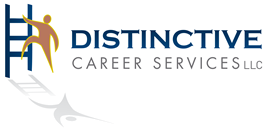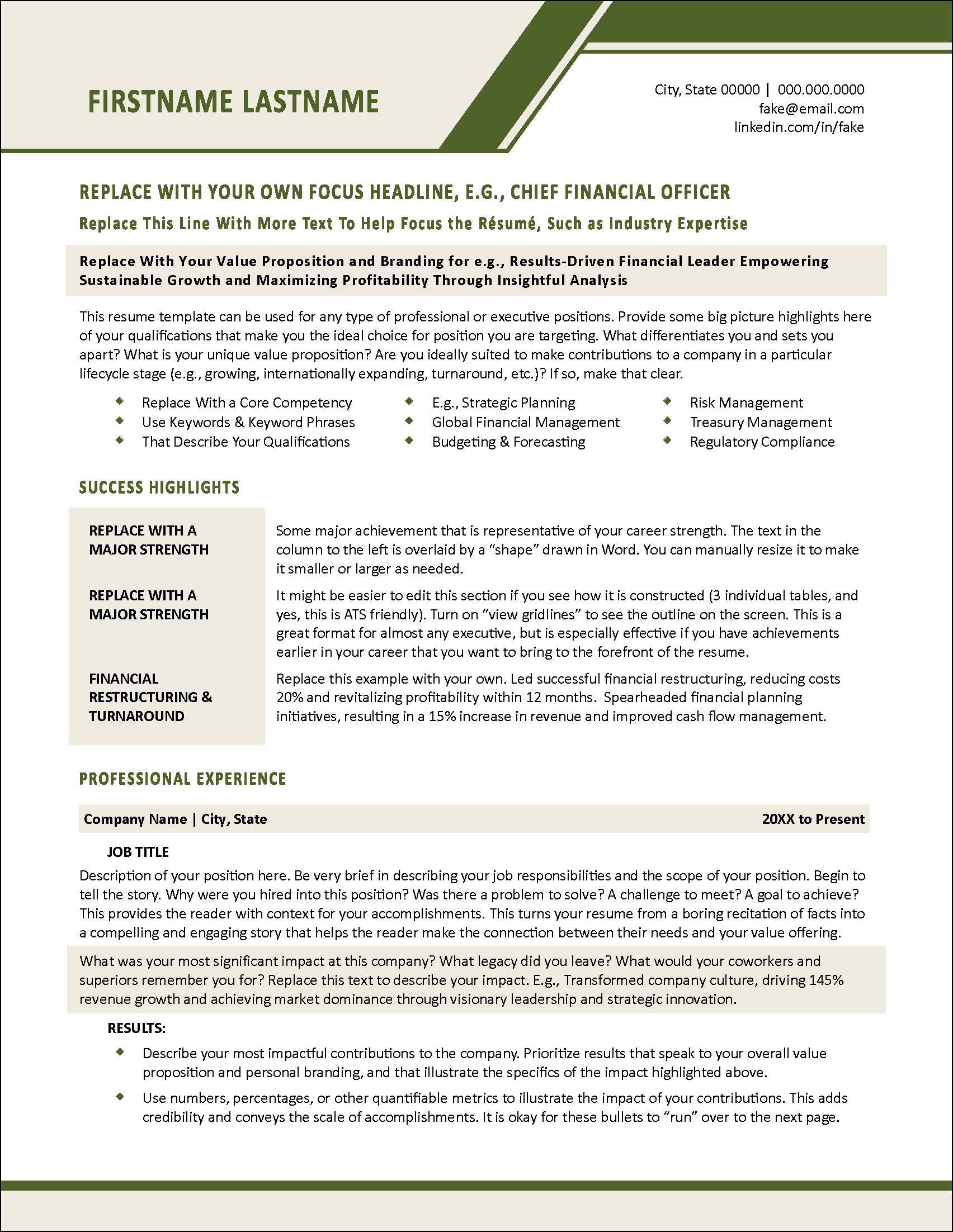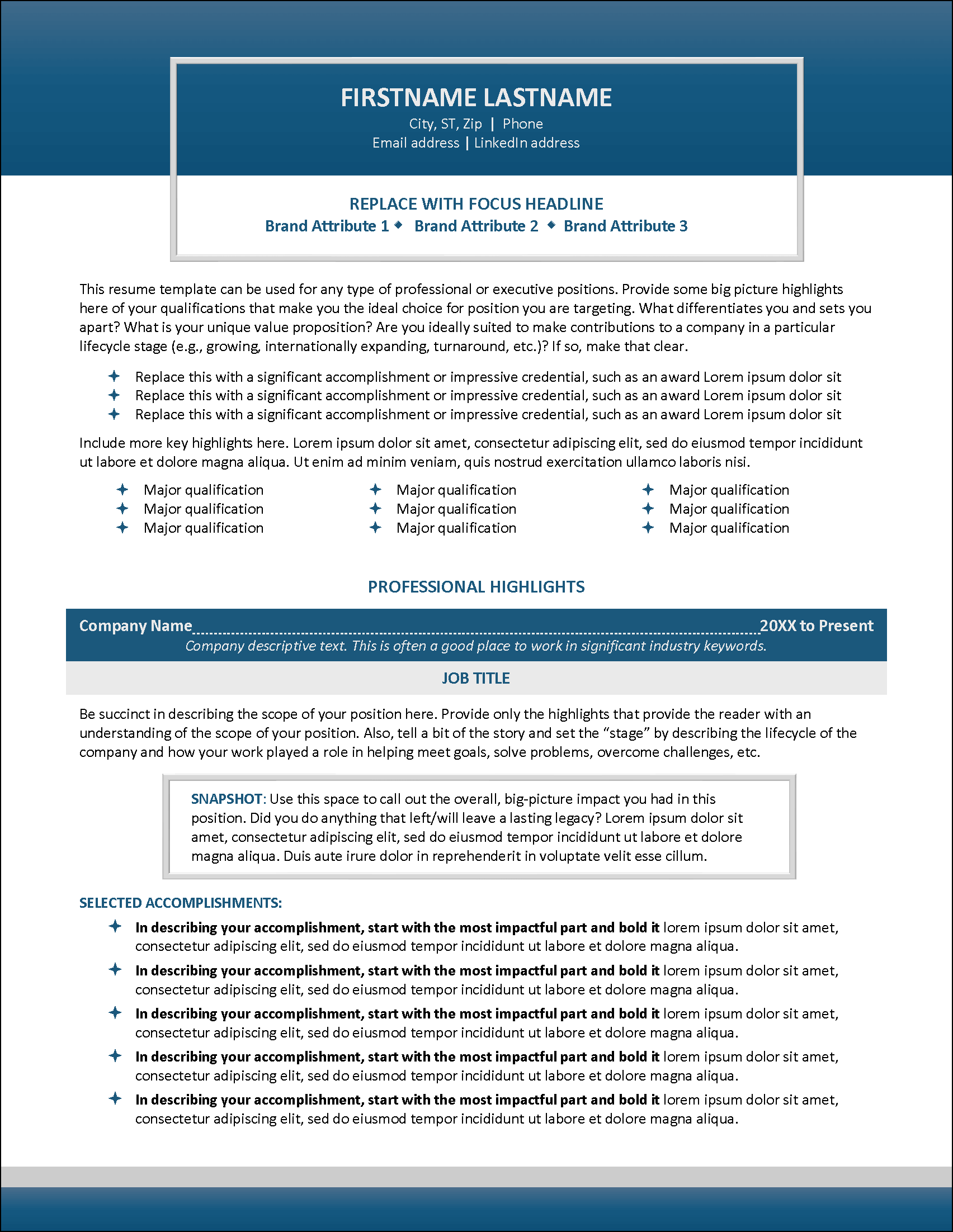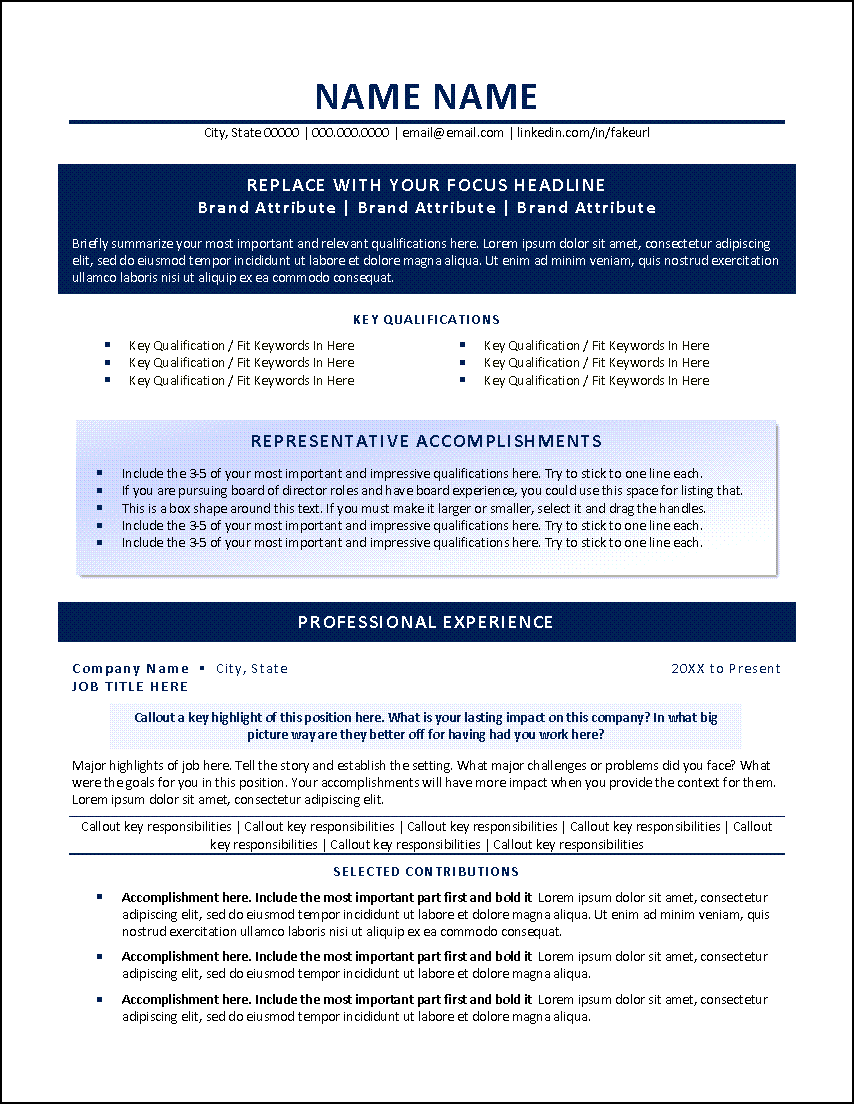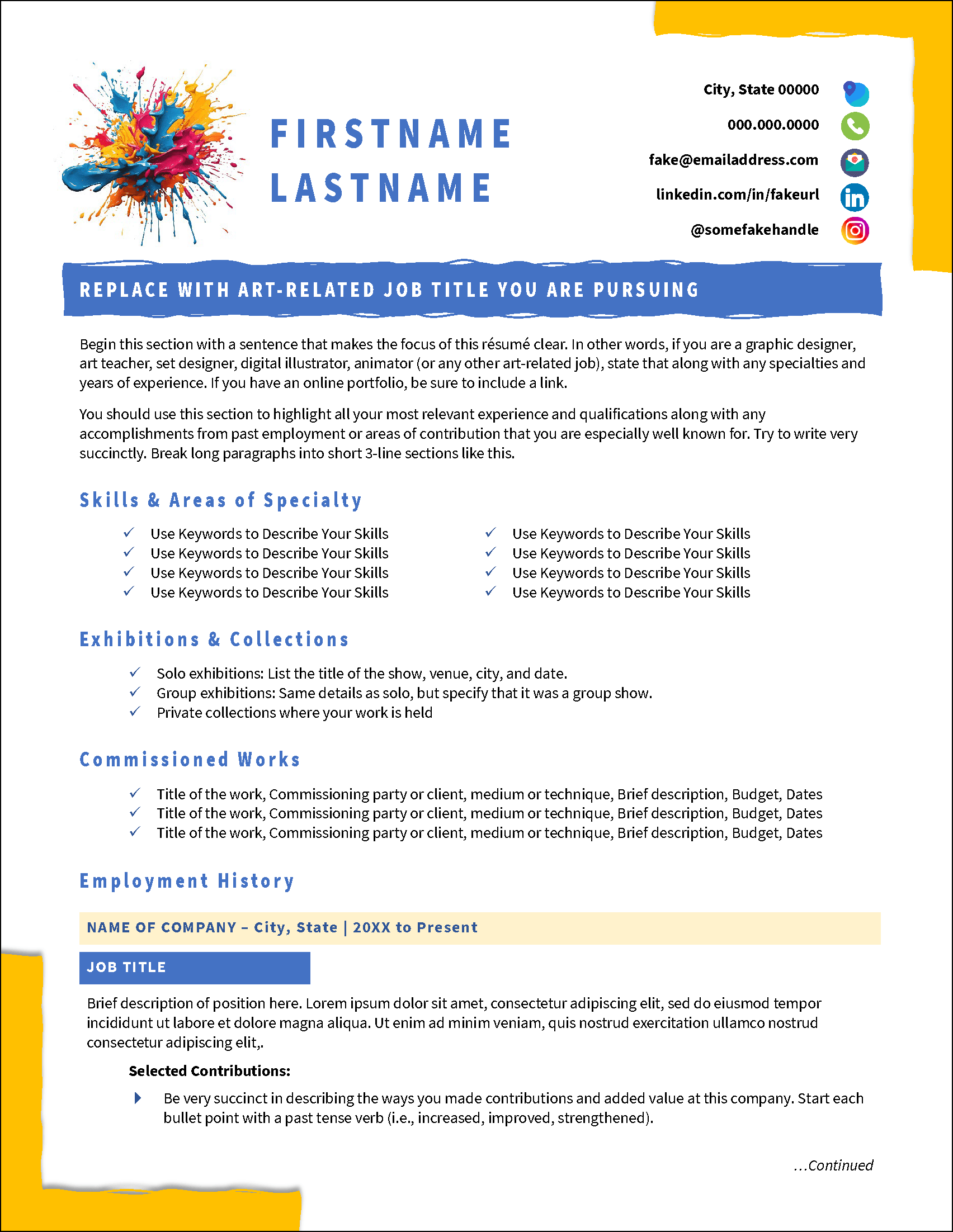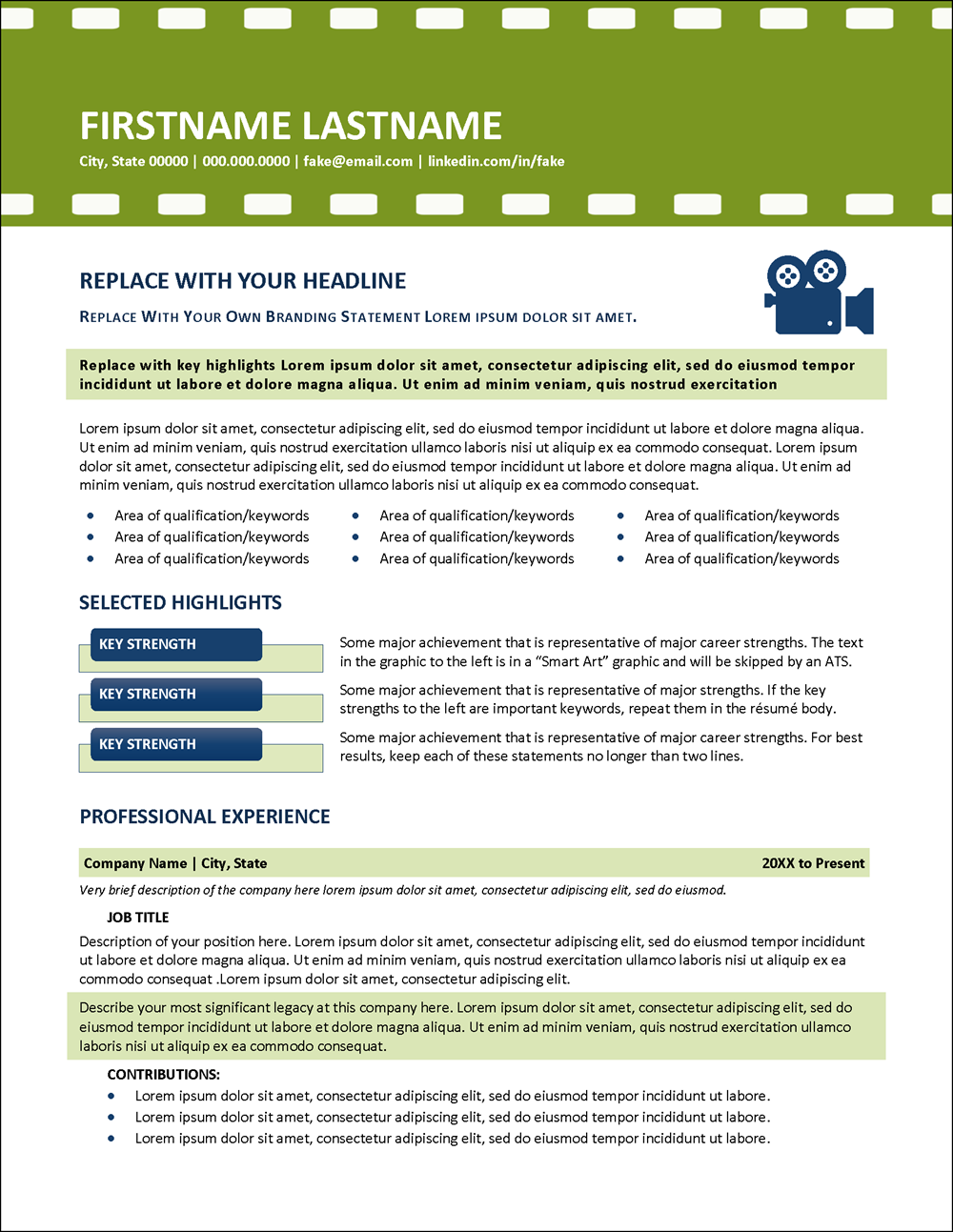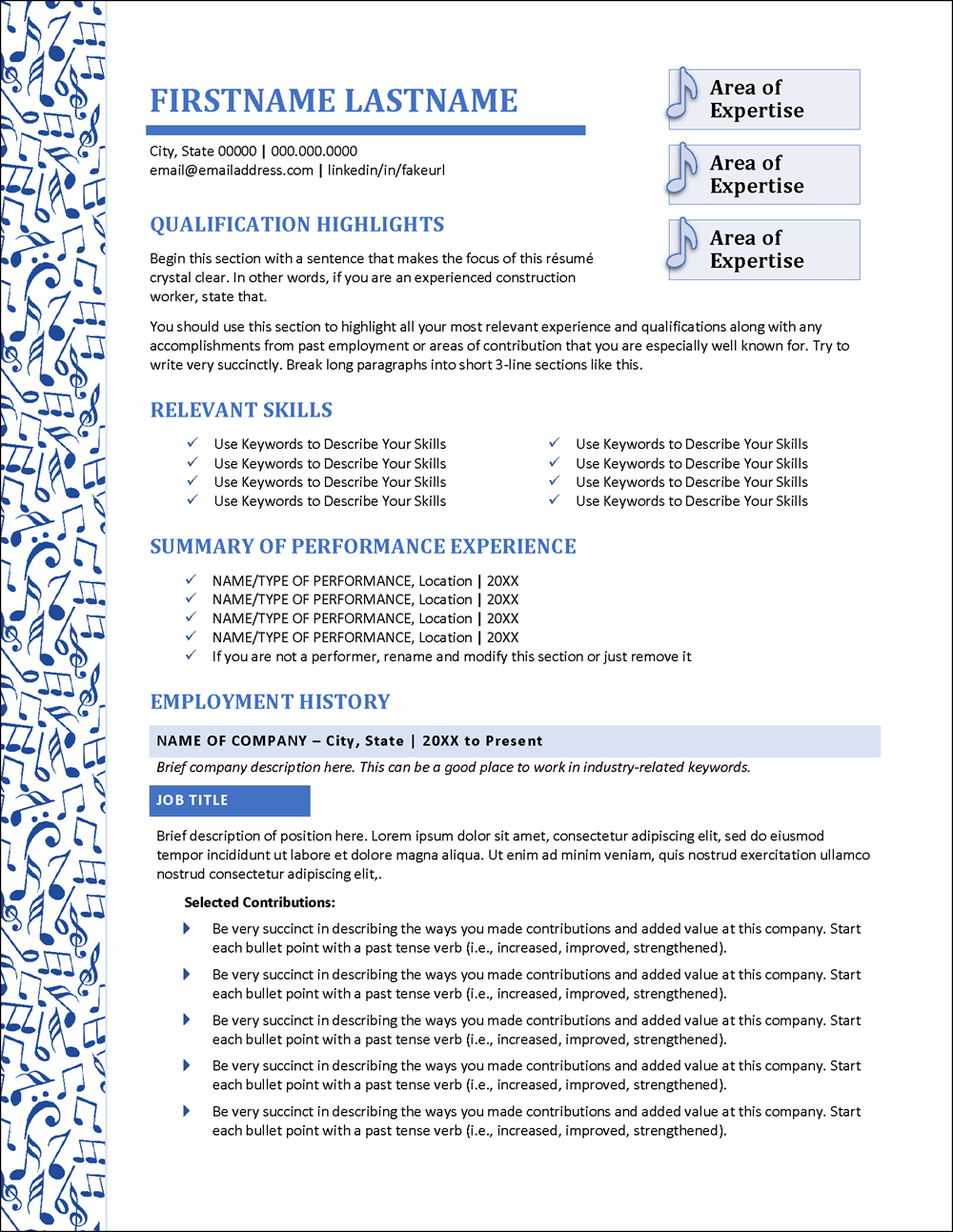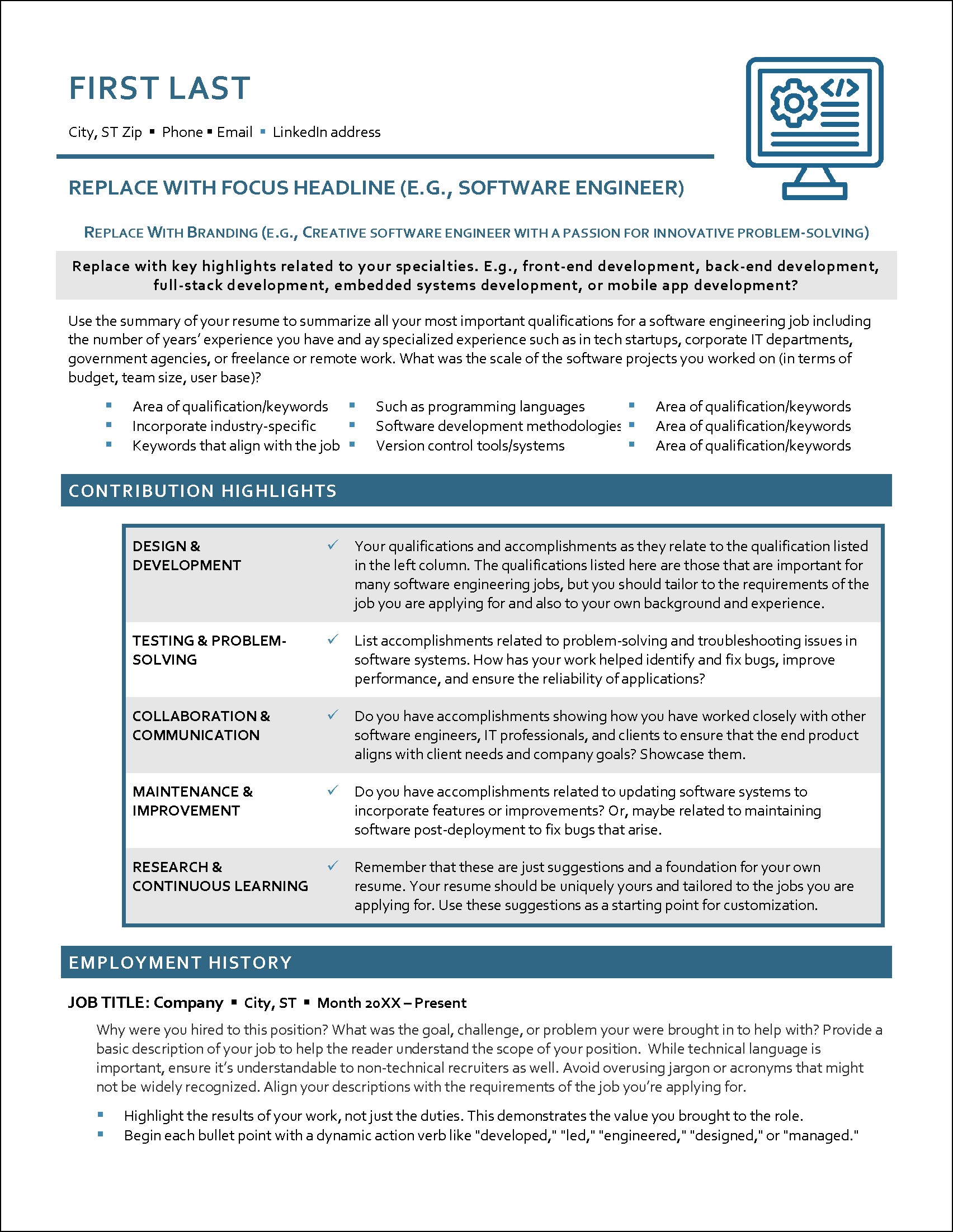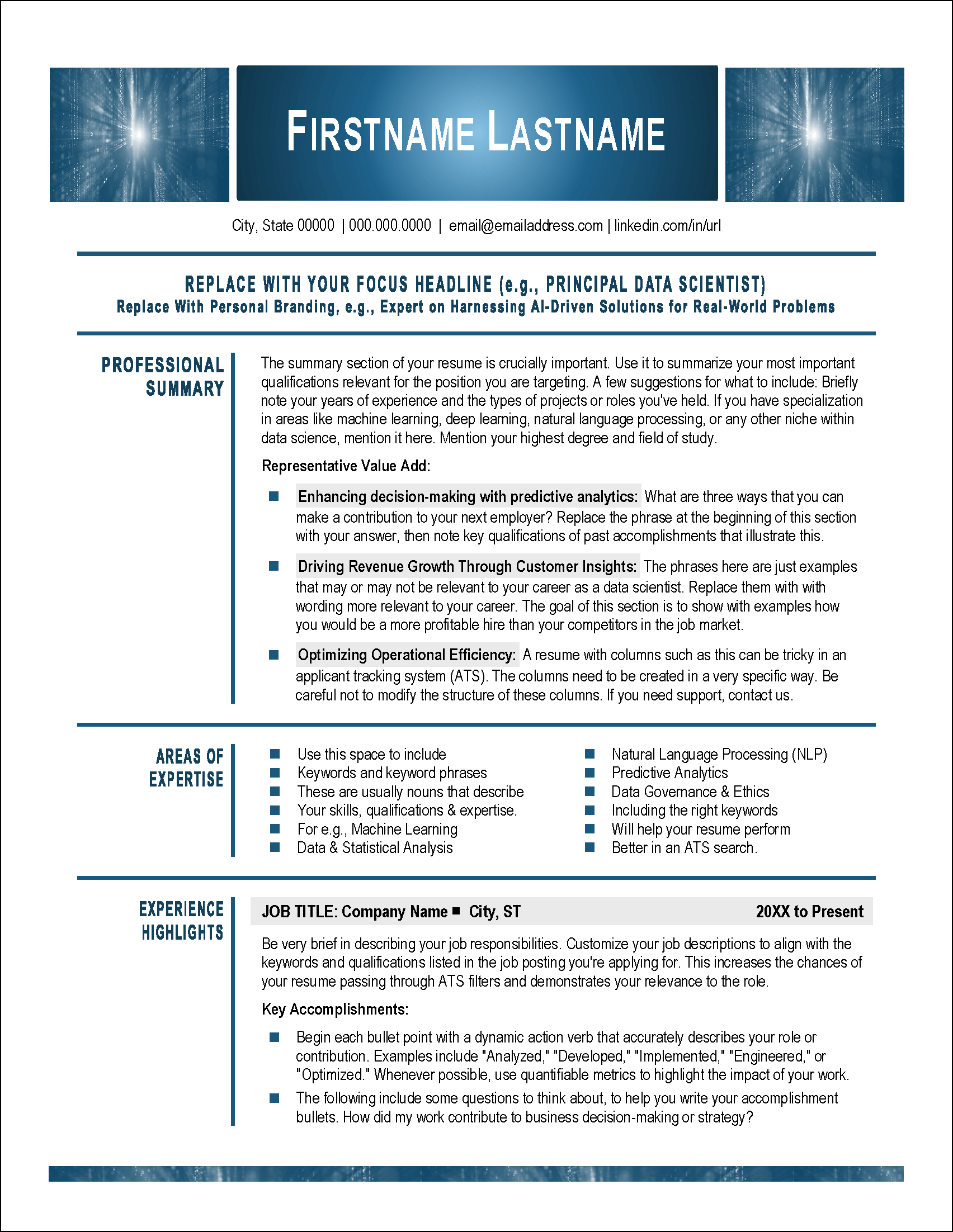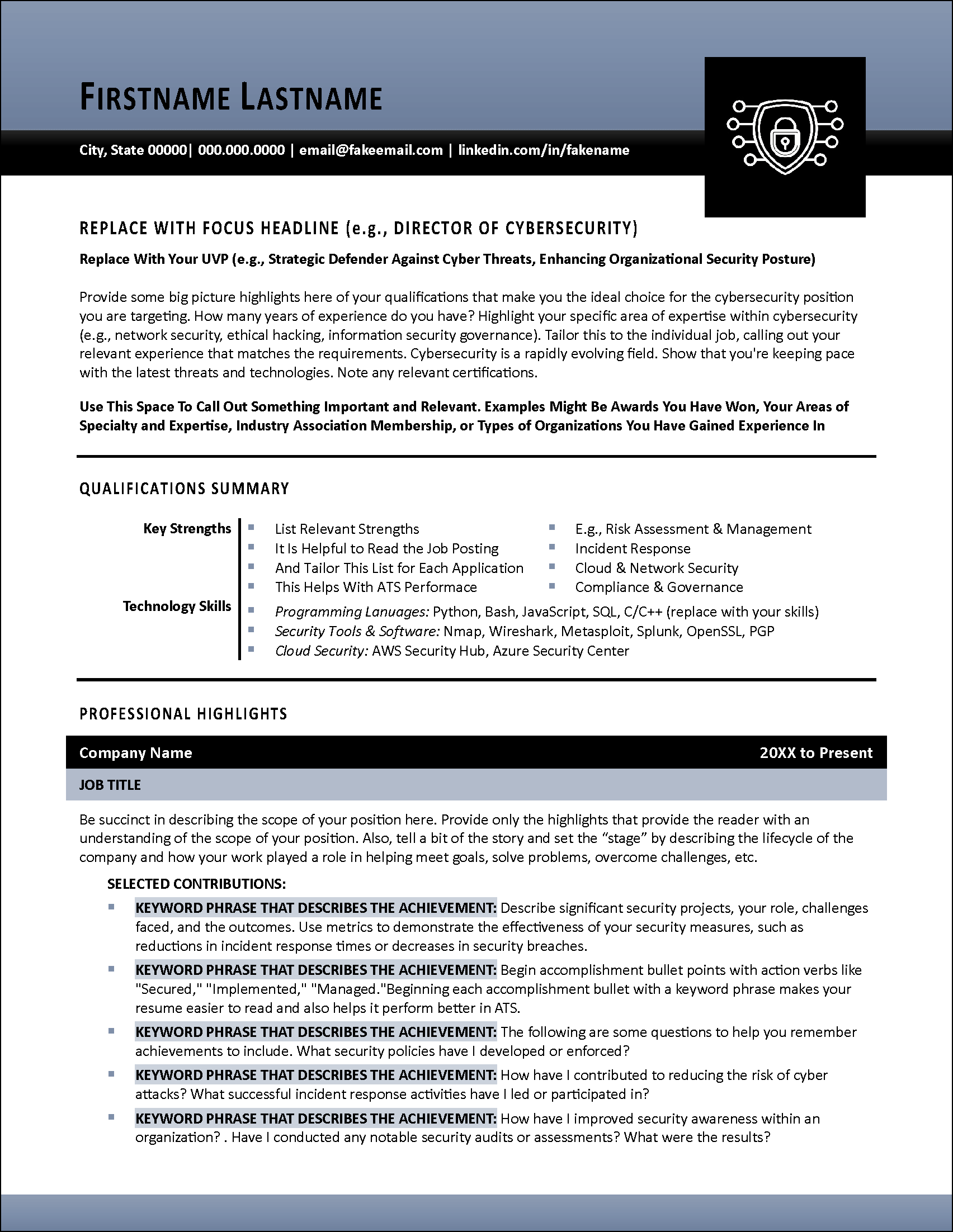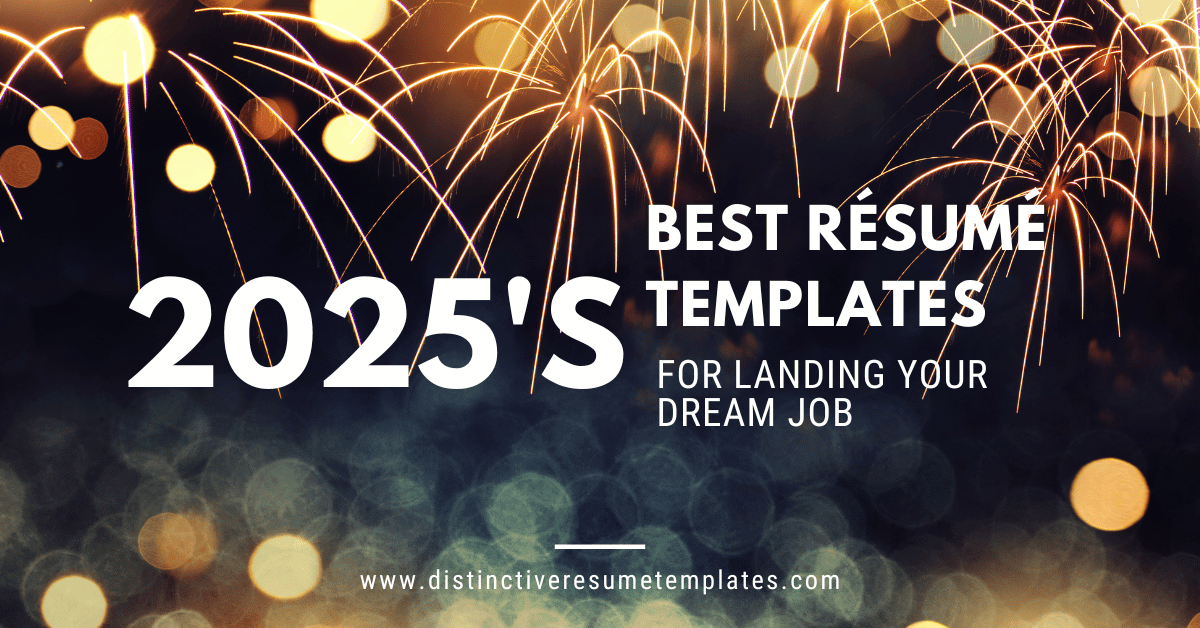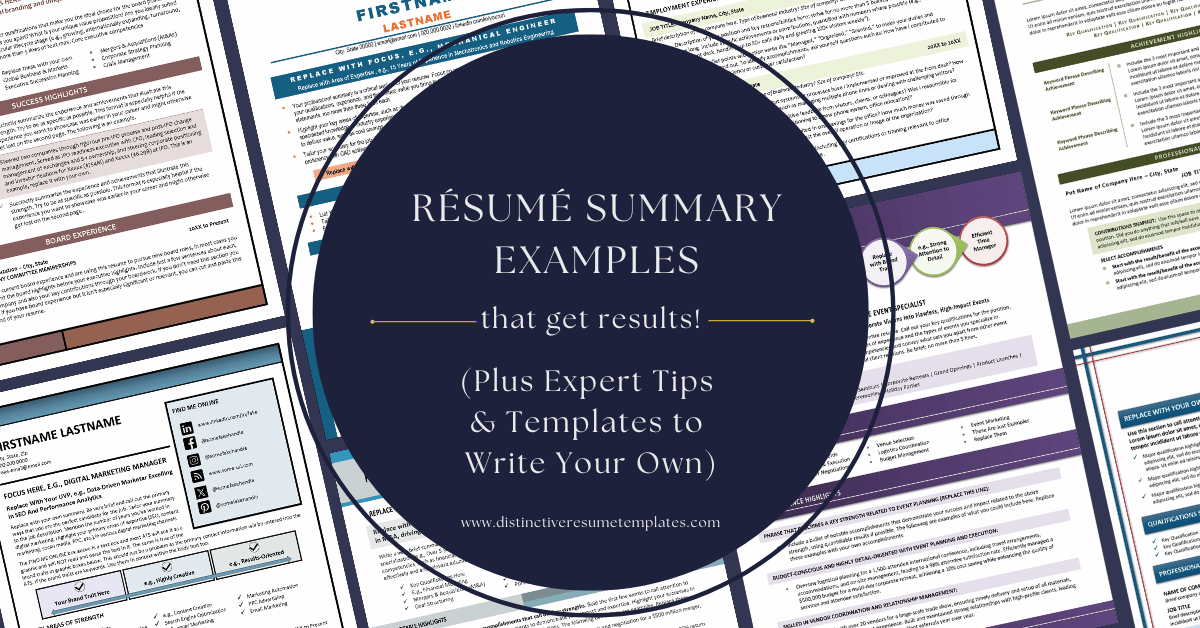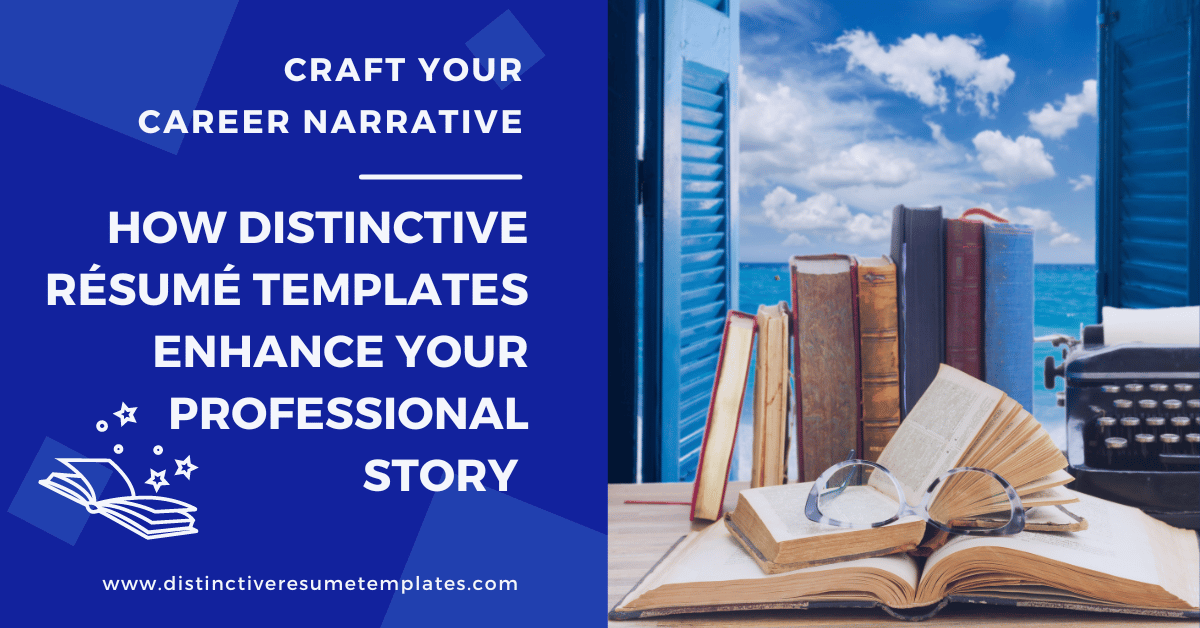
Imagine your resume as a blockbuster movie trailer. In just seconds, it needs to hook the audience—in this case, hiring managers—and leave them craving more. But how do you transform a dry list of experiences into a compelling narrative that makes employers reach for the popcorn?
Enter the art of resume storytelling.
For nearly three decades, I’ve been at the forefront of resume evolution, watching as the job market’s demands have shifted. Gone are the days when a bulleted list of job titles, responsibilities, and accomplishments could open doors. Today’s hiring landscape calls for something more—a resume that doesn’t just inform, but captivates.
With these expert insights, I created Distinctive Resume Templates, a collection of carefully crafted resume designs that marries form and function to help job seekers craft their career blockbusters. These aren’t just eye-catching resume designs; they’re strategic storytelling frameworks that guide you in weaving your professional journey into a narrative that resonates.
Even better these resume templates are also engineered to slip past the gatekeepers of the digital age—Applicant Tracking Systems (ATS). It’s like having a VIP pass that gets your story directly into the hands of decision-makers.
By incorporating storytelling elements into your resume, you unlock powerful advantages in your job search:
Distinctive Resume Templates are structured to naturally incorporate these storytelling elements, guiding you through the process of transforming your career history into an engaging narrative.
Each template provides prompts and sections designed to help you articulate your professional journey in a way that resonates with hiring managers and showcases your unique value proposition.
The result? A resume that not only informs but captivates—leading to significantly improved job search outcomes. Job seekers using this approach have reported increased interview rates, shorter job search durations, and even improved salary offers, all stemming from their ability to present their professional story in a compelling, structured manner.
So, are you ready to turn your career into a page-turner? Let’s explore how Distinctive Resume Templates can help you become the protagonist in your professional story—one that hiring managers won’t be able to put down.
Key Elements of a Story-Driven Resume
A compelling resume narrative goes beyond listing job duties and achievements. It weaves together several key storytelling elements to create an engaging professional story that resonates with potential employers. Understanding these elements can help you craft a more impactful resume:
Characters
Setting
Conflict
Resolution
Plot Development
Themes
By incorporating these storytelling elements, your resume transforms from a static list of experiences into a compelling narrative. This approach allows potential employers to see themselves as the main character in the story, with you as the capable guide ready to help them overcome their challenges.
The key is to structure your experiences and achievements in a way that clearly demonstrates how you’ve successfully guided previous employers through similar challenges. This narrative approach helps hiring managers envision how you could contribute to their organization’s success.
Remember, every aspect of your resume should contribute to the overall story of how you, as a skilled professional, can guide the employer to success. This perspective shift from a self-centered narrative to an employer-focused one can significantly increase the impact and relevance of your resume in the eyes of potential employers.
Structuring Your Career Narrative
Our resume templates use a proven structure to help you tell your story effectively:
- Professional Summary: Your “elevator pitch” that sets the stage for your career story
- Experience Section: Where you detail your professional journey, highlighting key plot points
- Achievements: The “resolutions” in your career story, showcasing tangible results
- Skills: The “tools” you’ve used to overcome challenges and succeed
Each template includes guidance on how to populate these sections to create a flowing narrative.
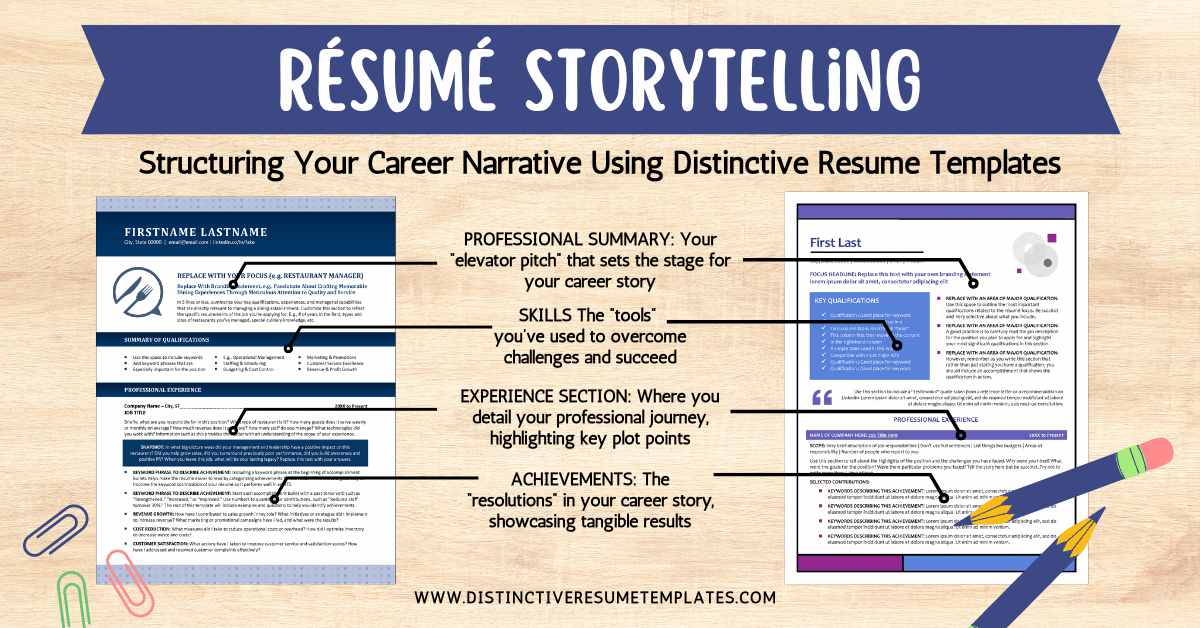
Tailoring Your Story to Different Roles
A crucial aspect of effective resume storytelling is adapting your narrative to fit different industries and positions. This customization ensures that your story resonates with the specific needs and expectations of various employers:
Executive Roles
For leadership positions, your story should emphasize strategic thinking and organizational impact. Focus on:
- Long-term vision and goal-setting
- Change management and organizational transformation
- Cross-functional leadership and stakeholder management
- Financial stewardship and resource optimization
From the Elevated Exec, Exceed, and Flexibil Collections, these are just several of many executive-style resume templates that make it easy to tell your executive career narrative.
Creative Positions
When targeting creative roles, your resume narrative should showcase innovation and unique approaches to problem-solving. Highlight:
- Original concepts and ideas brought to fruition
- Collaborative processes and interdisciplinary projects
- Ability to balance creativity with business objectives
- Adaptability in fast-paced, evolving creative environments
The examples above come from our Artivate resume template for artists, Entertainment Edge resume template for people in film and other entertainment jobs, and Musical Edge resume template for musicians.
Technical Roles
For technical positions, your story should demonstrate deep expertise and the ability to tackle complex challenges. Emphasize:
- Specific technical skills and proficiencies
- Complex project management and execution
- Innovative solutions to technical problems
- Ability to translate technical concepts to non-technical stakeholders
These example technical resume templates come from our CodePlus software engineer resume template, Data Driven, a collection that includes a resume template for data scientists, and SecureForce with a cybersecurity resume template.
By tailoring your narrative to the specific role you’re targeting, you demonstrate a clear understanding of what the employer needs and how you’re uniquely positioned to meet those needs.
Quantifying Your Impact
Numbers and measurable results add credibility and weight to your professional story. They provide concrete evidence of your capabilities and the value you can bring to a potential employer. When crafting your resume narrative, focus on quantifying your achievements in areas such as:
When incorporating these quantifiable achievements into your resume story, ensure they are relevant to the challenges and goals of your target employer. This approach not only validates your capabilities but also helps the employer envision the specific value you could bring to their organization.
Remember, while not every achievement can be quantified, striving to include measurable results wherever possible significantly strengthens your narrative and makes your resume more impactful.
Visual Storytelling in Resumes
While the content of your resume tells your professional story, the visual presentation plays a crucial role in how that story is received and understood. Effective visual storytelling in resumes involves thoughtful design choices that enhance readability, guide attention, and reinforce key messages. Here are some key aspects of visual storytelling in resume design:
Visual Hierarchy
A clear visual hierarchy helps guide the reader’s eye through your professional narrative:
- Use resume font sizes and styles to differentiate between sections, headings, and body text
- Place the most crucial information (like your name and key qualifications) prominently
- Employ bold or italicized text sparingly to emphasize important points without overwhelming the reader
Strategic Use of White Space
Proper use of white space (or negative space) is crucial for readability and focus:
- Balance text-heavy areas with open spaces to prevent visual fatigue
- Use margins and spacing to create distinct sections, making the resume easier to navigate
- Allow key information to “breathe” by surrounding it with white space, drawing attention to important details
Color Psychology
Thoughtful use of color on your resume can enhance your storytelling:
- Choose colors that reflect your industry or personal brand
- Use color consistently to create visual links between related information
- Be mindful of color contrast to ensure readability, especially if the resume might be printed in black and white
Information Flow
The resume layout should support a logical flow of information:
- Arrange resume sections in an order that tells your story most effectively (e.g., chronological for steady career progression, or functional for career changes)
- Use sections in the resume format to group related information, making it easier for readers to connect relevant details
Visual Elements and Infographics
Graphical elements can enhance your narrative when used judiciously (and with awareness of how they might impact ATS compatibility):
- Use charts or graphs to illustrate quantifiable achievements or skills proficiency
- Employ icons to quickly communicate ideas or categorize information
- Use Microsoft Word SmartArt to visually convey brand traits or key skills
Consistency and Branding
Maintain a consistent visual theme throughout your resume:
-
- Use the same resume fonts, colors, and styling across all sections
- If applicable, incorporate elements of your personal brand (like a personal logo) consistently
The Scan Test
Design with the understanding that recruiters often scan resumes quickly:
-
- Use bullet points for easy-to-digest information
- Ensure that key information stands out even during a quick glance
- Consider using sidebars or call-out boxes for crucial details you want to highlight (just be sure you understand how this can impact ATS compatibility and keyword optimization of your resume)
Adaptability
Remember that your resume might be viewed on different devices or printed:
- Ensure your resume design is readable and attractive when printed in black and white
- Test your resume layout on different screen sizes to ensure it remains effective on various devices
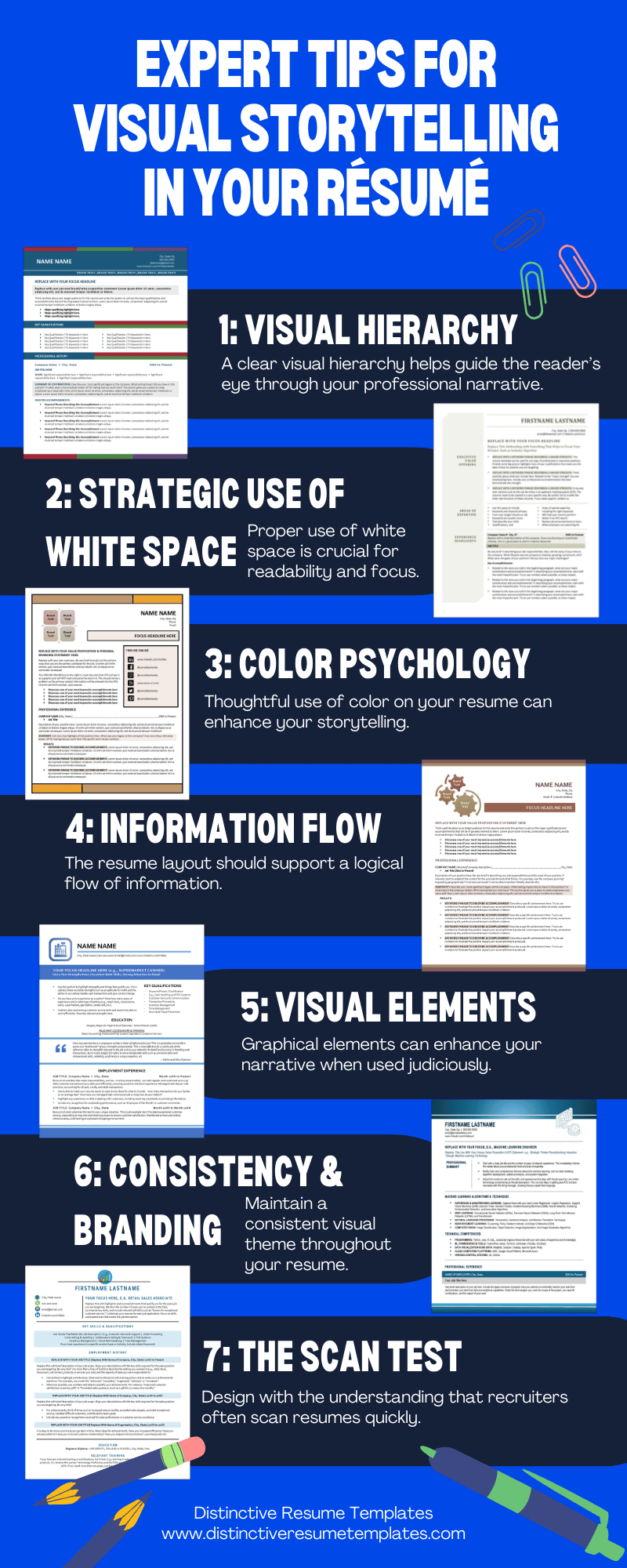
By thoughtfully applying these visual storytelling principles, you create a resume that not only conveys information but does so in a visually engaging way. This approach helps to keep hiring managers engaged with your professional narrative, increasing the likelihood that they’ll absorb and remember key details about your qualifications and achievements.
Effective visual storytelling in your resume complements your written content, creating a powerful tool that communicates your professional value both verbally and visually. This comprehensive approach to resume design helps ensure that your unique story stands out in a competitive job market.
Distinctive Resume Templates simplifies the process of creating a visually compelling resume that effectively tells your professional story. Our carefully crafted designs incorporate all the key elements of visual storytelling, from clear hierarchies and strategic white space to thoughtful resume color schemes and optional infographic elements.
Each template is built with a keen understanding of how visual elements can enhance narrative flow and highlight key information. With our user-friendly formats, you can easily input your information into pre-designed sections that are optimized for both aesthetic appeal and readability.
Whether you’re showcasing executive leadership, creative innovation, or technical expertise, our templates provide the perfect backdrop for your unique professional narrative. By using Distinctive Resume Templates, you can confidently create a resume that not only looks polished and professional but also visually guides hiring managers through your career story, making a memorable impression in today’s competitive job market.
Your Story, Your Success: The Path Forward
Crafting a story-driven resume doesn’t have to be daunting. With our thoughtfully designed templates, you have the structure and guidance needed to transform your professional history into a compelling narrative. By leveraging these tools, you can create a resume that not only informs but also captivates, setting you apart in your job search and inviting hiring managers to envision the next chapter of your career story—with them.
Ready to start crafting your career narrative? Explore our range of story-enhancing resume templates and begin telling your professional story today!
